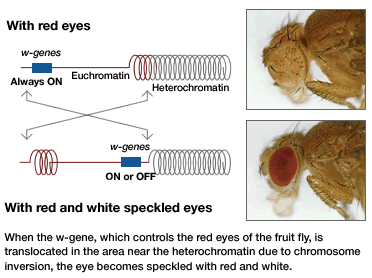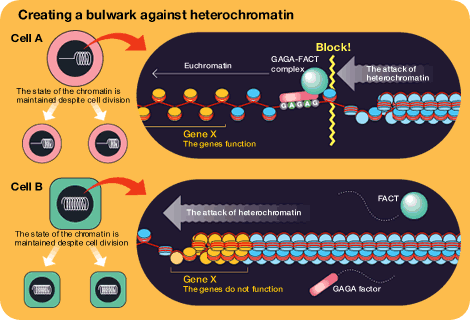| Research: Index > Chromatin supports cell memory |
| Chromatin supports cell memory | |
| |
The genomes of multicellular organisms are within the cell nuclei as chromosomes. These chromosomes have a complex shape with several strands of entwined chromatin fiber, consisting of a combination of DNA and histone proteins. One chromosome contains an area in which the chromatin is clumped together (heterochromatin), and an area in which it is loose (euchromatin). It is known that genes do not function well if they are present in those areas in which the chromatin is clumped together.
 |
| Also well known now are cases in which the eye of the fruit fly is speckled red and white. The explanation is that the genes controlling the fly’s red eyes have translocated in the area near the heterochromatin, with the result that some cells do not function. The nature of the cells in an individual is determined by how the genomes of the gene function. Once the function has been determined, their nature is fixed in memory, even during the later process of division. We have discovered that this cell memory, the basis for creating the body, is related to the manner of the presence of the aforementioned chromatin. |
| We discovered that the GAGA factor, which creates the boundary between heterochromatin and euchromatin, and FACT, which was blended with that factor, play an important role in cell memory. After the GAGA factor searches for the GAGAG sequence and combines with it to create the GAGA-FACT complex, it prevents the aggregation of the chromatin from that point forward. In other words, the chromatin will not bundle after the location at which the complex is formed, and the genes can function. If the complex is not formed, the heterochromatin will attack and the genes will not function. The combination of the complex as part of the GAGAG sequence in the genome and the dissociation determine the manner in which the genes function. This condition is maintained after the cells divide, so cells with the same characteristics are created. Our bodies are comprised of cells of different types. The order in our bodies is maintained by the continuity of cell memory, in which the state of the chromatin is maintained after cell division. |
 |
||
|
| ||
|
|
The meaning of the existence of predators in the natural world | ||
|
|
Iji Dozu: Observing movement | ||
| Rsearch |
|
Please close a window with the button of a browser who are turning off Javascript. |